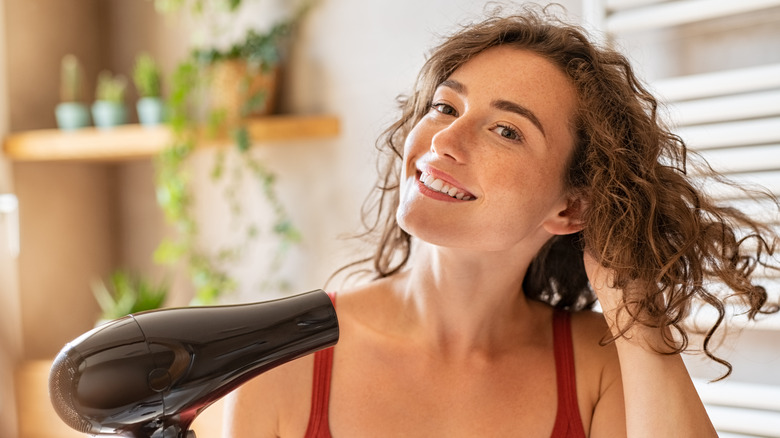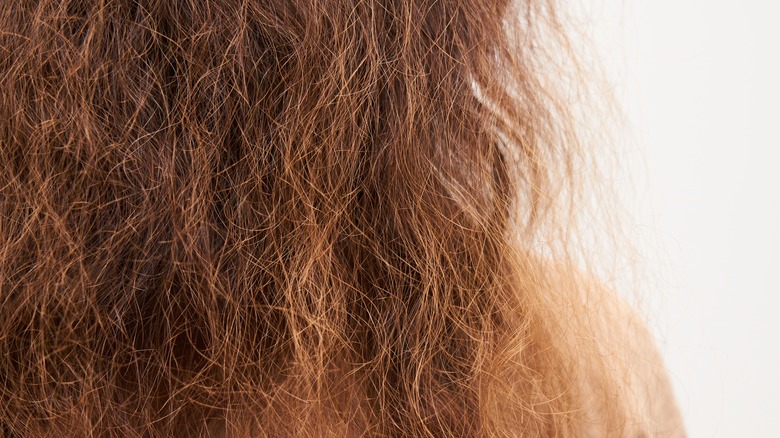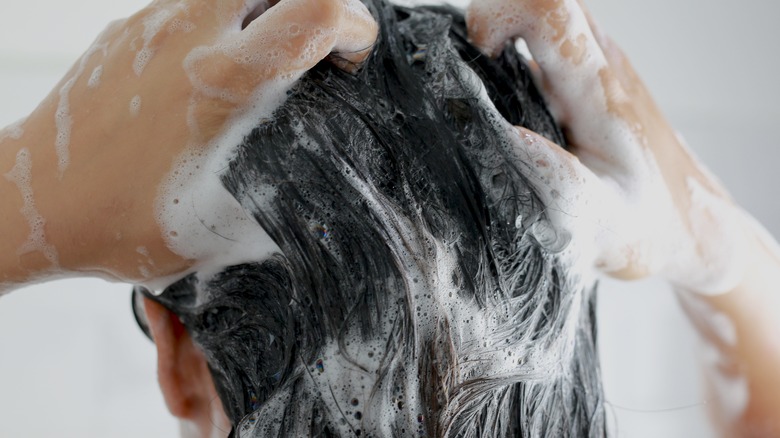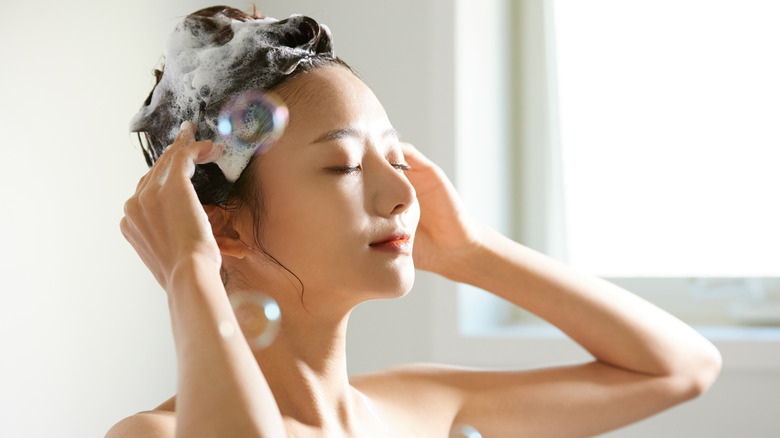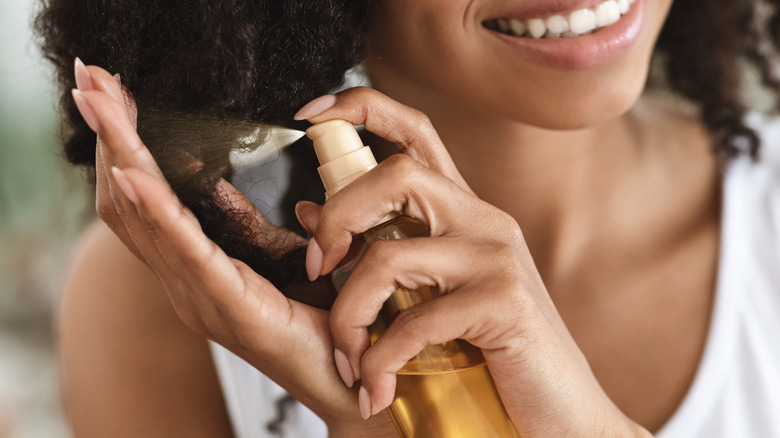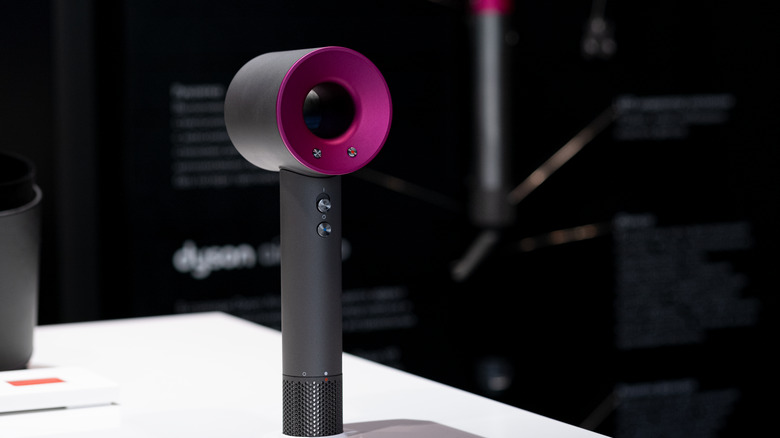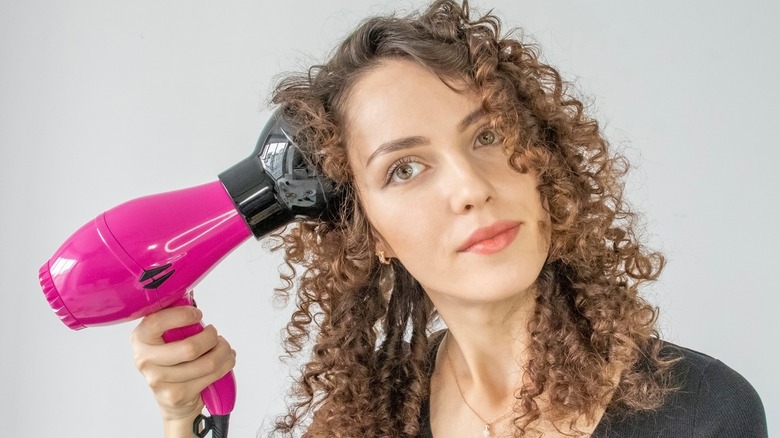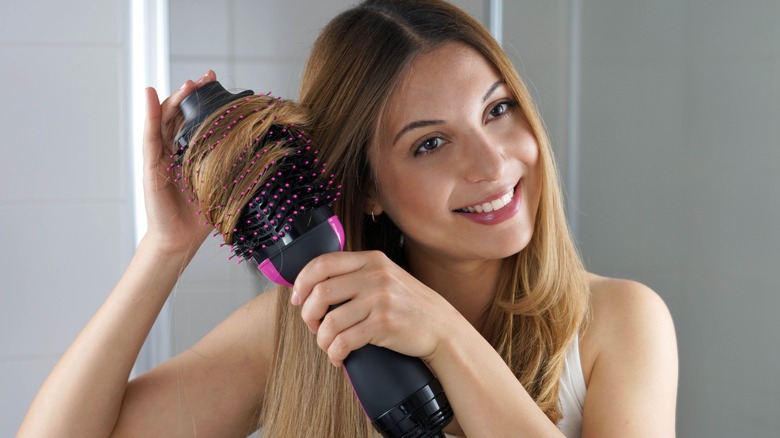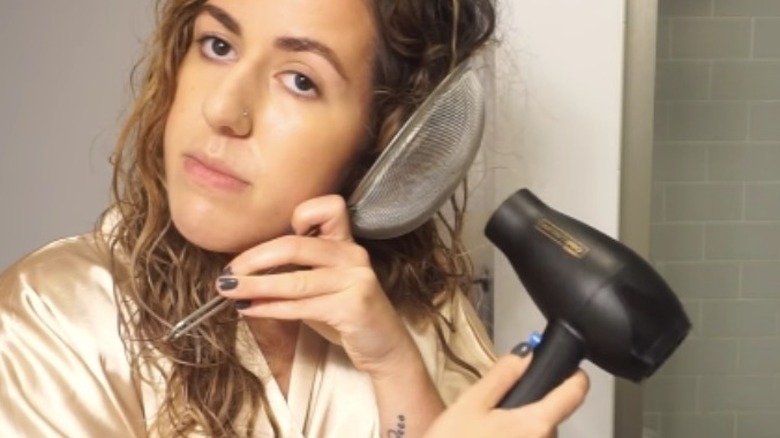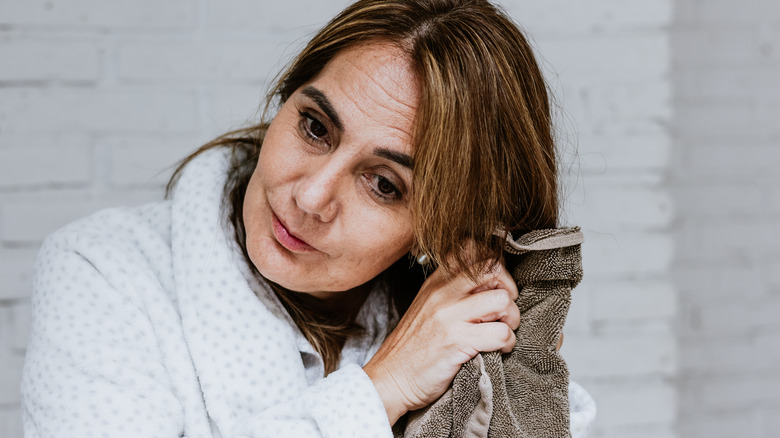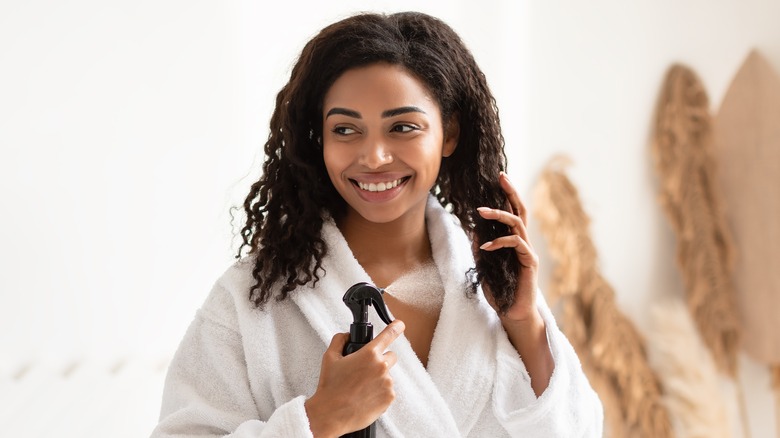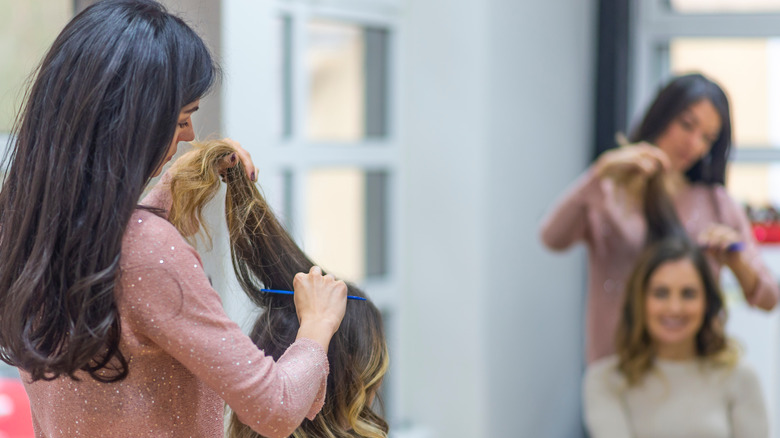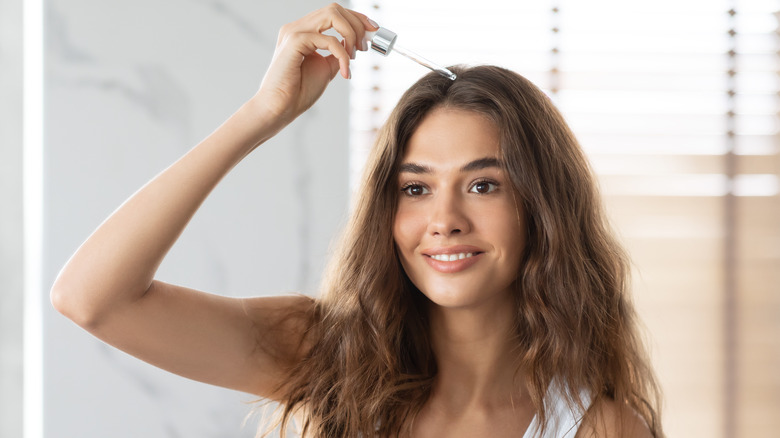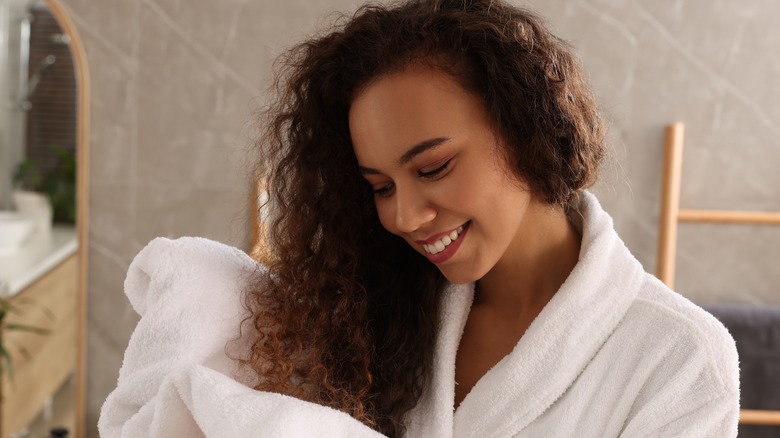Everything You Need To Know Before You Blow Dry Your Curly Hair
As any curly girl probably knows, curly hair can be pretty high maintenance. Dry it wrong, sleep on it wrong, brush it wrong, or touch it wrong, and your tidy curls can quickly transform into an annoying halo of frizz and flyaways. But even though learning how to take care of your curly hair can take time, once you know how to give your hair what it needs, you'll never look back.
One of the hardest things to learn is how to blow dry curly hair properly. Unlike straight or wavy hair, which can easily be blow dried without any hair dryer attachments, special serums or blow drying techniques, curly hair requires a bit more time, effort and practice. After all, if you try to blow dry your curly hair the "normal" way, you'll probably be left with, well, what can only be called a huge mess on the top of your head.
But don't panic! Today, we'll be talking you through everything you need to know before you start to blow dry your curly hair, from the pre-care to the final touches, so that you can dry your hair and be left with neat, bouncing curls. To bring you the best practices, we chatted with a couple of expert hair stylists to find out some tips you can try at home.
Blow drying curly hair the normal way can leave you with a whole lot of frizz
Many people with naturally curly hair shy away from the blow dryer, preferring to scrunch and air dry their hair. That's because using a hair dryer without any tools or brushes separates the natural curls and leaves you with a large pouf of frizz on top of your head.
"It's the heat and the air that often open the hair cuticles and make it frizzy," stylist Yvey Valcin tells us, adding, "but it's all about preferences and what you want the hair to look like when it's dry."
"Aiming a blow dryer at sections of your hair and drying your hair that way will certainly frizz your curls," warns Ghanima Abdullah, hair expert and cosmetologist. In fact, very few people should ever try this carefree blow drying technique. "Even for people with straight hair, if they don't use a brush while drying, they also end up with frizz," she said. "It's almost impossible to dry curly hair with anything but a round brush, which produces larger, wavy curls."
How you shampoo and condition your hair matters
Before even picking up the air dryer, you'll have to actually wash your hair. This may sound obvious, but it's worth discussing in detail, because how you wash your hair actually makes a big difference to how it looks at the end of the process.
"How you shampoo and condition is critical because curly hair loves to suck up residue such as product buildups and other environmental stuff like CO2," says Valchin. He recommends doing a double shampoo to help "open the hair cuticle," preparing it for your conditioner and serums later on. "Follow this up with a moisturizing conditioner as curly is often thirstier," he adds.
Another great technique is to actually wait a day or two after washing before doing any blow drying. "Shampoo dries out curls significantly and so does the hot air," Abdullah tells us. Curls love moisture, so waiting can help reduce dryness. "It's better to wait a few days, allow your normal conditioning routine to balance your hair, then wet it again and blow dry."
Add a weekly hair mask into your routine
A weekly or bi-weekly hair mask can be a wonderful way to replenish your curly hair with some moisture, especially if you want to blow dry it after a wash. As one 2022 study in the Asian Journal of Management Sciences and Education found, using a hair mask can help to make the hair more manageable, shiny and smooth, while also reducing frizz — even if it's only left on the hair for a couple of minutes. So, it's definitely worth adding one into your routine, even when you're pressed for time. But remember, the longer you leave on the mask, the more the product can penetrate the hair.
"A hair mask is a must, at least once a week, because that routine allows the hair to remain healthy," says Valchin. And, as Michael Shaun Corby, Living Proof's creative director, told Glamour, a strengthening mask is always an extra good option for curly hair, which can be "extra fragile." "I recommend turning this into a treatment by leaving it on for 5 to 10 minutes," he said.
Prepping the hair with leave-in curling products is key
After you've washed, conditioned and applied a mask to your hair, it's time to prep the hair with a leave-in conditioner, cream or serum before you start the blow drying process. "The hot air has a tendency to frizz hair, so you want to counter that by using curl-enhancing products first," suggests Abdullah. Be sure to choose one or two products that suit your hair type. When in doubt, look for products that condition the hair. "Any product with a conditioning agent is good for curls," says Valchin.
At this stage, it will be key that you apply your hair product in the right way. As hair expert Diane C. Bailey told Byrdie, the best method is to start at the ends of your hair before working your way upwards. This will help avoid product build-up at the scalp, which can make your hair look greasy and weighed down. It will also help to deliver moisture in the areas where your hair needs it most.
Chloe Metzger, beauty director at Cosmopolitan, recommends trying products such as Ouai's Curl Creme and Ouidad's Avdanced Climate Control Heat and Humidity Gel.
Use the right hair dryer for your hair type
Unfortunately, not all hair dryers are created equal, especially when it comes to curly hair. Some will be better suited to maintaining smooth curls than others.
The most important factor when choosing a hair dryer is air flow strength. "There are just few in the market where you can control the setting of the air flow," warns Valchin. "Some have negative and positive ion settings built-in that help with smoothness or adding more texture. Using the right hair dryer is important, because some hair dryers open the hair cuticle which can over dry the hair."
According to Abdullah, the best of the best is the Dyson Supersonic, which has a unique round shape to help ward off frizz and comes with several add-on attachments and brushes. "But if you're on a budget," she says, "there are plenty of Dyson product dupes that do the same thing. Just look for a hair dryer with the same shape and specifications."
Try using a diffuser attachment
There are several different hair drying methods that have been shown to reduce frizz and leave you with long-lasting, smooth, well-defined curls. One of the most popular is diffusing.
A diffuser is a large, flat toothed hair dryer attachment that helps to diffuse the air coming out of the hair dryer so that you can blow dry your curls without sending your hair flying all over the place. As Valchin says, "Diffusing the curls is usually the best approach — using a diffuser helps to manage the curls better."
To use a diffuser properly, split your hair into small sections, then carefully place each section on the diffuser, before moving the hair dryer up and holding it against the skull so that your section of hair is compact. Then, turn on the hair dryer for about a minute. Turn off the hair dryer before moving it to avoid disturbing the curl pattern. Repeat all over your head until the hair is completely dry.
You could use a comb or another attachment, too
Another technique that can help you manage your curly hair is to use a comb or brush attachment on your hair dryer. While this technique will break up the curl pattern, it's a great way to create smooth waves or even straight hair. "It's an easier way to style your hair while you're drying it, instead of using a round brush," says Abdullah. However, be warned that this technique may require some practice. "Brushing your hair while drying needs a lot of extra hand-to-eye coordination, especially when you're working with the back of your head," she says.
If you want to give this drying technique a try, begin with the brush at the top of your head, then slowly work down the length of your hair, running the brush through small section. Keep your arm straight if you want a straight look, or, twist the brush gently away from your face as you go to create a soft wavy salon-style look. Tread carefully, though — this technique isn't always suited to people with very tight curls.
Try using a sieve or strainer if you don't have the right tools
If you don't have the tools you need to blow dry your hair properly, there are tricks you can try to keep your curls in place while as you go. One of the most popular is using a sieve or strainer — yep, a metal sieve straight from the kitchen. "If you don't have a diffuser, a metal sieve can help spread the air in a similar manner," says Abdullah. "This can help keep frizz down while drying curly hair." Valchin suggests trying the sieve technique as sometimes, it might actually suit your curls better than a diffuser. "Taking time to understanding your texture is always the way to go, by doing this you'll know what approach works best for your hair," he says.
To try the sieve technique, start with damp hair. Then, separate the hair into small sections. Collect a section in the sieve, then bring the sieve up towards the scalp, just as you would do with a diffuser. Then, use your hair dryer to blow the section of hair dry through the sieve. Repeat with each section of hair all over your head until the hair is completely dry.
This is also a great technique to have up your sleeve for days when you're away from home and don't have access to your usual tools.
Remove excess water from the hair first
Once you've decided which tools and hair dryer you're going to use, it's time to start drying. First things first — it's important not to start drying if your hair is still soaking wet. Instead, get rid of some of the excess water first.
"Curly hair holds a lot of water after a wash, so it's very important to remove excess water before using products," Valchin suggest. "However, you have to keep a spray bottle close by, because curls also tend to dry fast, and if when that happens it's important to spray the hair throughout the style you are creating."
While you could remove water by simply wringing out your hair over the tub, Abdullah recommends another technique. "Apply your curl products, then accordion your hair into a towel upside down," she says. "Leave it tied in the towel (right side up) for twenty minutes. Not only does this technique remove extra water from your hair, it also enhances the curl." That way, when you start drying, your hair will already have its natural curl pattern.
Apply a heat protectant to reduce damage
Another final step before you turn on the hair dryer is applying a heat protectant spray or cream. Heat protectant products help to protect your hair from damage caused by the hot air coming from your hair dryer. As a 2011 study in the Annals of Dermatology noted, hair dryers can cause damage with consistent use, such as "roughness, dryness and loss of hair color." A protectant can prevent this.
"Heat protectant is always necessary, especially if you are using tons of heat on the hair," warns Valchin. "Curls are very sensitive to heat, so protect your curls against heat at all cost!" He suggests looking for a hair cream that contains heat protectant to keep your routine simple.
Abdullah suggests steering clear of oil-based heat protectants. "Many have low smoke points that will burn your hair when used with a blow dryer or other heat tool," she says.
Blow dry your hair in clipped back sections to avoid frizz
While it may be tempting to quickly pass your hair dryer over all of your hair at once, experts suggest slowing down and working in smaller, distinct sections of hair. "We all know those commercials with a woman with long, silky hair blow-drying their hair in one swoop without any sections," Abdullah says knowingly. "Those commercials are made for aesthetic reasons only." In other words, if you try this technique at home, you'll probably be very, very disappointed. In fact, according to Abdullah, this technique will lead to frizz for straight hair, too — "but it's especially true for curls," she adds.
The less your hair gets tangled and frizzy, the better — and sectioning your hair off with clips works well as an alternative. "Sectioning the hair when dying it is a great approach, it will help minimize unnecessary frizz and volume," says Valchin. "Also, you'll have more control in creating curl formations."
Oils are great to use once the hair is dry
Contrary to popular belief, adding oil to the hair won't actually make it oily. Instead, it can leave your hair feeling nourished, moisturized and smooth. "If you are looking to add a little shine to your curls, finish off with more oils for a healthy shine," suggests Valchin.
However, it's important to save your hair oil for the final step. After all, as any amateur chef knows, oil plus heat equals, well, cooking! "Don't use oils in your hair before drying as they might cause your hair to scorch," warns Abdullah. "Instead, apply them for nourishment and shine after you blow dry."
Oils are great for smoothing the curls once you've finished drying. They're also great for on-the-go haircare. For instance, if it's a windy day, you may find that your curls get blown around and you're left with flyaways and frizz. Simply smooth out your curls with a dab of oil and you'll be good to go.
Sometimes, your curls prefer being air dried
While blow drying your hair is a great way to speed up your morning routine, for curly haired girls, it might not actually always be the best practice. If you have time, the experts actually recommend letting your hair air dry from time to time. "Hair can sustain a lot when using the proper products, but it's best to air dry the hair routinely to keep the hair healthy," says Valchin.
A 2011 study in the Annals of Dermatology found that contrary to popular belief, air drying the hair from soaking wet can be more damaging than blow drying. However, on the flip side, consistent blow drying can also be damaging. So, the experts recommend using both methods — and using low heat when possible.
Several air drying methods to try include scrunching damp hair with your hands and plopping. Plopping involved piling damp hair on top of your head, then wrapping your head in a cotton t-shirt. "If you apply your curl product and plop your hair, you will have amazing curls without the need for a dryer," says Abdullah. "And your hair should dry thoroughly in two hours after plopping." You can also try the plopping technique after rough drying your hair to remove some dampness to speed up the process.
